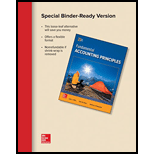
Concept Introduction:
Prepaid expenses - Prepaid expenses are part of accounting adjustment entries which are recorded in the closing period of the entity. These are those expenses which have not yet incurred but have been paid in advance. These are recorded in the books following the matching principle of accounting.
To determine:
1. The current account balance,
2. The current account balance, and
3. The necessary
Explanation of Solution
a.
1. The current prepaid insurance account balance = $4,700
2. The prepaid insurance account balance as on Dec.31 = $ 900
3. The adjustment entry
| Particulars | Debit | Credit |
| Insurance expense | 3,800 | |
| To Prepaid Insurance Account | 3,800 |
b.
1. The current prepaid insurance account balance = $5,890
2. The prepaid insurance account balance as on Dec.31 = $ 4,850
3. The adjustment entry
| Particulars | Debit | Credit |
| Insurance expense | 1,040 | |
| To Prepaid Insurance Account | 1,040 |
c.
1. The current prepaid rent account balance = $24,000
2. The prepaid rent account balance as on Dec.31 = $ 20,000
3. The adjustment entry
| Particulars | Debit | Credit |
| Rent expense | 4,000 | |
| To Prepaid Rent Account | 4,000 |
Want to see more full solutions like this?
Chapter 3 Solutions
Loose Leaf for Fundamental Accounting Principles
- Which accounting principle requires that expenses be recorded in the same period as the revenues they help generate?A. Cost PrincipleB. Revenue Recognition PrincipleC. Matching PrincipleD. Full Disclosure Principlesolve it.arrow_forwardIn pension accounting, actuarial gains and losses are____. a) Recognized in other comprehensive income b) Always recognized immediately in profit or loss c) Deferred indefinitely d) Added to pension obligation directlyarrow_forwardDC Co. exchanged equipment and $25,000 cash for similar equipment. The book value and fair value of the old equipment were $120,000 and $135,000, respectively. Assuming that the exchange has commercial substance, DC would record a gain/(loss) of __.arrow_forward
- Please show me the valid approach to solving this financial accounting problem with correct methods.arrow_forwardHelp with accounting questionarrow_forwardWhich accounting principle requires that expenses be recorded in the same period as the revenues they help generate?A. Cost PrincipleB. Revenue Recognition PrincipleC. Matching PrincipleD. Full Disclosure Principlearrow_forward
- I need guidance with this financial accounting problem using the right financial principles.arrow_forwardWhat is the formula for calculating the weighted average cost of capital (WACC)?A) WACC = (Cost of Debt × Proportion of Debt) + (Cost of Equity × Proportion of Equity)B) WACC = (Cost of Debt + Cost of Equity) / 2C) WACC = Cost of Debt + Cost of EquityD) WACC = Proportion of Debt + Proportion of Equityarrow_forwardIf a company has annual sales of $840,000 with a gross profit margin of 35%, what is the cost of goods sold?arrow_forward

 AccountingAccountingISBN:9781337272094Author:WARREN, Carl S., Reeve, James M., Duchac, Jonathan E.Publisher:Cengage Learning,
AccountingAccountingISBN:9781337272094Author:WARREN, Carl S., Reeve, James M., Duchac, Jonathan E.Publisher:Cengage Learning, Accounting Information SystemsAccountingISBN:9781337619202Author:Hall, James A.Publisher:Cengage Learning,
Accounting Information SystemsAccountingISBN:9781337619202Author:Hall, James A.Publisher:Cengage Learning, Horngren's Cost Accounting: A Managerial Emphasis...AccountingISBN:9780134475585Author:Srikant M. Datar, Madhav V. RajanPublisher:PEARSON
Horngren's Cost Accounting: A Managerial Emphasis...AccountingISBN:9780134475585Author:Srikant M. Datar, Madhav V. RajanPublisher:PEARSON Intermediate AccountingAccountingISBN:9781259722660Author:J. David Spiceland, Mark W. Nelson, Wayne M ThomasPublisher:McGraw-Hill Education
Intermediate AccountingAccountingISBN:9781259722660Author:J. David Spiceland, Mark W. Nelson, Wayne M ThomasPublisher:McGraw-Hill Education Financial and Managerial AccountingAccountingISBN:9781259726705Author:John J Wild, Ken W. Shaw, Barbara Chiappetta Fundamental Accounting PrinciplesPublisher:McGraw-Hill Education
Financial and Managerial AccountingAccountingISBN:9781259726705Author:John J Wild, Ken W. Shaw, Barbara Chiappetta Fundamental Accounting PrinciplesPublisher:McGraw-Hill Education





